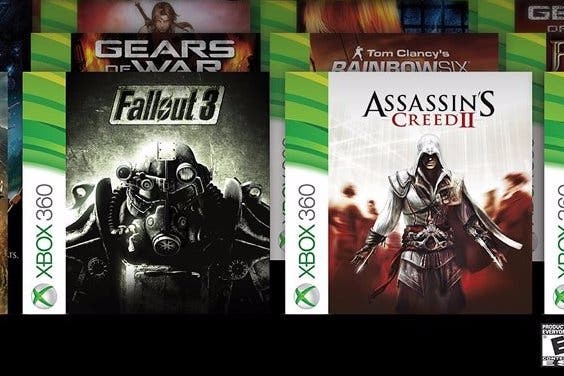Xbox One backward compatibility: every major game tested
UPDATED: Does Bayonetta on Xbox One offer the definitive experience? Also: Forza Horizon, Mirror's Edge and many more titles added.
UPDATE 10/9/16 3:00pm: Full analysis added for Bayonetta, Forza Horizon, Mirror's Edge, COD2, Red Dead Redemption and the Undead Nightmare DLC.
Original story: We've been working on this one for some time. Microsoft stunned the gaming world last year when it announced that Xbox One would offer backward compatibility for Xbox 360 titles. It's a technological miracle considering the architectural differences between the two systems, but with the feature now fully rolled out and over 100 compatible titles available, we wanted to put it to the test. In this extensive feature, we've road-tested every major Xbox 360 game you can run on Xbox One: all of the Gears of War titles, Halo Reach, Assassin's Creed 2 - everything. On top of that, the feature is regularly updated with every major title put through its paces.
But before we dive into the game specifics, it's worth pointing out just how well Microsoft has integrated this feature and the extent to which Xbox One plumbs in effortlessly into the existing Xbox 360 infrastructure. Getting started couldn't be easier - Xbox One supports both digital downloads and original Xbox 360 discs straight away, provided you're running the updated dashboard. Digital games automatically populate your available downloads list under the Games and Apps category while discs can be popped in and prepared for installation with little hassle. However, whether your game is on disc or available digitally, each game must be downloaded from Xbox Live. This is due to the fact that each download includes an Xbox One specific package containing files necessary for operation - the package acts as a wrapper allowing in to function within the Xbox One interface.
In addition to basic functionality, Xbox One is able to make full use of save files from your original Xbox 360. If you have saves on your older console that you'd like to use with Xbox One, you can simply copy the relevant files to your cloud storage and Xbox One automatically uses them. Being able to pull up saves from 2005 and use them with a different console in 2016 is very convenient and impressive indeed. Even better, as long as you stick to the cloud drive, saves can be used interchangeably between an Xbox One and Xbox 360 console.
Based on a wealth of extended testing, capture and analysis we can safely say that our experience has been positive. Games generally operate without issue, but that doesn't mean there aren't a few hitches here and there. In a few instances, games simply fail to start properly instead returning an error message after sitting at the splash screen for a minute or so. In another case, when trying to install a game using the disc, the console simply returned a generic "something went wrong" error, requiring us to reboot the console before continuing. Truthfully, these minor snafus are just that - minor - and have little impact on the general experience, but they are certainly worth taking note of.
The general experience is also designed to closely match the original hardware rather than greatly enhance the rendering quality - which means that games won't operate at higher resolutions or with improved anti-aliasing. Games do appear somewhat darker on Xbox One than on Xbox 360, strangely enough, but we did at least note a slight improvement in upscaling quality, which is a nice bonus.
There are a handful of additional minor improvements present as well. Vertical sync is now mandated at a system level meaning that screen tearing is eliminated completely on every title - we mentioned this in our original look at this feature and it still holds true today. Hard drive and disc access operations also tend to have less of an impact on performance on Xbox One. This often translates into faster performance during data streaming operations that would otherwise interrupt the experience. Elevators in Mass Effect load faster while hitches are reduced in Fallout 3, just to name a couple of examples.
General performance seems to vary between Xbox One and 360 in many games with certain sections running smoother through the virtualised environment, while others still run faster on original hardware. If we speculate for a moment, it seems entirely likely that the performance variation has a lot to do with how the original hardware is being taxed in any given context. When games perform a large number of draw calls and scenes are flooded with complex interactions, the CPU becomes a bottleneck.
The 3.2GHz PowerPC tri-core CPU used in Xbox 360 is certainly the most challenging part in this emulation puzzle so it seems possible that saturating these virtual cores can lead to a loss in performance. It's for this reason that you might see faster performance in cut-scenes, which rely more heavily on the GPU (where Xbox One's advantage is unassailable), while draw-call heavy situations, which place more of a burden on the CPU, incur a greater performance hit.
Bayonetta
Status: Generally excellent, tear-free performance on Xbox One
Platinum Games' Bayonetta remains one of the very best action games ever made, and we couldn't wait to check out how well it plays on Xbox One running via backward compatibility. The issue is this: the Xbox 360 game is brilliant, but is impacted by performance dips and some obvious screen-tear. By default, Xbox One back-compat sorts the tearing completely, giving us a completely v-synced presentation - but what about performance?
The video below represents a thorough playtest of Bayonetta, not just on Xbox One but also stacked up against the Wii U version too - with some bonus PS3 'lulz' added for good measure too. The end result? Well, all three of the 'prime' Bayonetta experiences all have their performance advantages in some areas, so there's no clear win for the Xbox One here, but it's also clear that some effects work causes genuine issues on the Wii U game - something that isn't an issue on Xbox One and Xbox 360. PS3? Well, we'll leave that to the video.
One thing we did note is that while tearing may have been eliminated via back-compat, it does come at the cost of a slight hit to input lag - it's a touch higher on Xbox One once the adaptive v-sync tech is stripped out of the game, so die-hard series purists may prefer the original experience. The bottom line? Backward compatibility has once again succeeded in bringing a classic last-gen title over to modern hardware with little compromise and if you bought Xbox One without previously owning Xbox 360, or if you never played the game at all, we strongly recommend checking it out.
Forza Horizon
Status: Isolated issues for some users, but flawless for most
We've enjoyed seeing backward compatibility on Xbox One result in performance improvements that exceed the quality of the original experience running on Xbox 360 hardware, but we must remember that the new machine can never exceed the capped frame-rates set by the original code.
Enter Forza Horizon - a game that sticks absolutely doggedly to its 30fps target pretty much from start to finish. At the very least, the Xbox 360 may rarely output one or two torn frames - essentially invisible to the human eye - and of course, these vanish when running the title on Xbox One. But the bottom line is that we have a locked refresh on Xbox 360 and thankfully, this is mirrored on Microsoft's latest console. It's as solid an experience as you could hope for.
Curiously, some users have reported some lurching and stuttering - we were unable to replicate it at all, but Microsoft says it is aware of the problem and is looking to fix it. A new preview dash is out and seems to show promising improvements.
Mirror's Edge
Status: Significantly improved performance on Xbox One, marred by an ugly flickering artefact
Available on Xbox One backwards compatibility for some time, this title was omitted from our initial testing and we wanted to revisit it in order to fill in that gap - especially as the title becomes free in September 2016 as part of Microsoft's Games with Gold initiative.
The original was standard Unreal Engine 3 fare - capped at 30fps and utilising an adaptive v-sync, locking when on point and tearing when the engine is under load. On Xbox One, the tearing is completely absent of course, but the good news is that performance is significantly improved, with the classic DICE title more doggedly sticking to its target frame-rate.
However, there's a bizarre issue where elements of the presentation strobe and flicker on Xbox One, making the improved playback rather more challenging to stomach for extended periods. We aren't the only ones affected by this and hope Microsoft sorts this issue in time for the Games with Gold release later this month.
Call of Duty 2
Status: Massively improved on Xbox One
Revisiting the original Call of Duty 2 on Xbox 360 today, the frequency of its lurching stutter is actually quite remarkable. The game always targeted a full 60fps output, but utilises a double-buffer v-sync set-up. There's a 16.7m render budget per frame, but consistently failing to hit that target causes a 33ms stutter - in effect, the game is momentarily running at 30fps, before returning to its target. For a game like Call of Duty 2, this creates a jarring sensation as it switches between these two refreshes - almost like slowing the game down whenever you were faced with any real action.
The increase in performance running the game on Xbox One is plain to see. Watch the video below and most of these drops are eliminated - leaving you with a clean 60fps line most of the way. It's not a perfect read-out though: you do get the odd hiccup here and there, but the opening Stalingrad campaign mission shows Xbox One only really buckling with lots of enemies on-screen. But the point is that it's rare that this happens, while the alpha-based effects that gave the Xbox 360 so much trouble are no longer an issue with the newer hardware's more powerful GPU.
It's still running at the same resolution of course - native 720p. And as you would expect, the Xbox One visuals are a complete match for its delivery on original Xbox 360 hardware. There's no improvement there, but the feel of the game and the quality of its all-important low latency controls sees a huge improvement. Based on our tests, there are no more lurching frame-rates, and where there is a drop it's usually settled within a few seconds. Call of Duty 2 is a somewhat barebones title by today's standards, but we had a lot of fun revisiting this title. If the game is in your old Xbox 360 collection, it's well worth checking out on Xbox One.
Red Dead Redemption/Undead Nightmare
Status: Significantly improved on Xbox One
As ever, Red Dead Redemption runs with a 30fps cap on both Xbox 360 and Xbox One, and never goes above that line. But just like the Grand Theft Auto games, the Xbox 360 original struggles to maintain 30fps around busy towns with lots of NPCs, and character close-ups in cut-scenes. At its worst, the game hard-locks to 20fps at these points; a flat line that adds a perceptible judder to any camera movement. Screen tearing was also an issue on Xbox 360 too, though well hidden at the top of the screen, but the real distraction was its frame-rate drops.
Back-compat support on Xbox One changes all of this, with improved frame-rates and the outright removal of screen-tear. Inevitably there's a dynamic time of day in place that makes precise 1:1 visual comparisons difficult, but we're getting the same native 1280x720 resolution here - in our shots upscaled to 1920x1080. Image quality is nearly identical, barring a slight halo effect to high-contrast details on Xbox One - an issue we've seen in many Xbox 360 titles running on Microsoft's newer machine.
Elsewhere, there are no concerns with Xbox One's accuracy in replicating the last-gen look; we get same textures, lighting effects, texture filtering, and draw distances as before. All of this means the core advantage to playing via back-compat is the performance.
For every stress point we've found near Armadillo Town, it's clear all 20fps dips on last-gen are replaced with a straight 30fps line on Xbox One. It almost constantly runs at a smoother, higher frame-rate, and the removal of screen-tear is also a big plus. The one exception to this is a bandit shootout at Ridgewood farm, where Xbox One drops to 26fps at lowest - a weakness matched by Xbox 360 just a few seconds later. Putting this dip aside, the game otherwise runs at a higher refresh on the newer machine in all other tests.
It's great news for Red Dead Redemption fans then, and Xbox One hands in the best-optimised version of the game to date. It clears up Xbox 360's performance drops to a radical extent - which to this point has been the preferred version - and with no real compromise to its visuals either. The only negative here is the implication that Xbox One back-compat support rules out a true remaster effort from Rockstar, which we'd have love to have seen.
The good news only continues when we take a look at performance in the Undead Nightmare expansion - performance dips on Xbox 360 during gameplay are far more sustained than they were in the original Red Dead title, and once again, the Xbox One is capable of adhering to the 30fps target more consistently.
Call of Duty: Black Ops
Status: Improvements to performance in a few scenes, but the experience is mostly very similar
One of the most anticipated titles to hit Xbox One backwards compatibility, Black Ops still has a die-hard following online, with multiplayer matches still raging on over five years after it released. And of course it was the game that put Treyarch on point for the series, with the team pushing dynamic lighting and effects to new heights in a Call of Duty title.
So, it's a game that Microsoft needs to get right, and thankfully it has. Unlike a few other back-compat titles, there are no issues with black crush here, so details in dark scenes are displayed in the same way as on 360. Aside from differences in how the Xbox One scales the game's 720p output - it renders natively at 1040x608 - compared to your HDTV handling this with the 360 console, image quality is also unchanged, and there are no improvements to effects like texture filtering to be found.
However, performance is a little more interesting, and looking at the campaign there are times when higher frame-rates are measured on Xbox One. The on-rails shoot-out set on the plane at the end of the first stage, and the opening cut-scene both deliver a near solid lock at 60fps, whereas Xbox 360 performance here can be 10-13fps lower. It makes a massive difference, with controls feeling more consistent while running the game on Xbox One.
Unfortunately, this boost in performance is something of an outlier, and regular shootouts that tax the engine play out with almost identical frame-rates across both consoles. This means variances in frame-time and drops down to around 40fps when the action really heats up, and running the game on the Xbox One doesn't solve these issues. Online multiplayer also sees no obvious improvements or compromises, and a near solid 60fps is offered up when playing the game on both 360 and Xbox One. The experience here is basically the same, and there are no obvious downsides to playing via backwards compatibility.
So overall, Black Ops works very well when played on Xbox One, with no issues marring the experience that didn't already exist in the original game. Improvements to performance are somewhat thin on the ground, but frame-rates are no worse than running the game on 360, and for the most part the game looks and functions to the same standard on both consoles.
Dark Souls
Status: No tangible improvement to performance - experience impacted with additional frame-pacing and black crush issues
Microsoft unleashed Xbox One support for the original Dark Souls simultaneously with the launch of the latest franchise entry in Japan, and suffice to say that we've been anticipating this one for quite some time. We've noted that some GPU-bound Xbox 360 titles actually run better on Xbox One - like Alan Wake - so we were hoping that some of the performance black spots in Dark Souls may actually see a frame-rate uplift on Microsoft's latest console.
Well, the truth is that not much has changed in terms of the overall performance profile. Areas that dropped to 20, 15 or even 10fps on the original Xbox 360 are similarly impacted on Xbox One. Frame-pacing is also noticeably worse, meaning that 30fps areas often see 16, 33 or 50ms updates, as opposed to the mostly flat, more pleasingly consistent 33ms seen on Xbox 360. There are some improvements to glitching seen when entering a new area though: similar to Fallout 3, we suspect that accessing storage is faster on Xbox One, smoothing out the minor issues here.
However, the gamma level seen on Xbox One playback is a trouble spot. Dark areas see detail vanish into an inky blackness, making the game much harder to play. It doesn't reach the levels of unplayability seen with the Remedy titles, but it's clearly not right and we wish that Microsoft would address this issue.
Alan Wake
Status: Improved performance overall
Just in time for Quantum Break, Microsoft has made Remedy's Alan Wake available on Xbox One via the system's backwards compatibility feature. The original game was a showpiece for the Xbox 360 in many ways but its low resolution and regular screen-tearing sapped away some of its polish - so how does it hold up on Xbox One?
Well, it's a bit of a mixed bag. Performance-wise, Alan Wake now operates at a very steady 30fps on Xbox One with only minor dips interrupting fluidity. It's a smooth experience and the emulator eliminates all traces of screen-tearing leading to a more consistent presentation. While the game's pseudo-sequel, Alan Wake's American Nightmare, offered users the choice between adaptive v-sync or double buffer v-sync, that option is not available in the original game. Xbox 360 players have no choice but to put up with torn frames as a result.
So if performance is improved on Xbox One, why doesn't this version get our wholehearted approval? The truth is that Alan Wake suffers from a severe case of black crush. Shadow detail is completely lost in many scenes making it difficult to make out your surroundings. It's an issue that seems inherent to the emulator on Xbox One and something we've noticed in the past, but few of those games are as dark as Alan Wake. American Nightmare also suffers from this problem but this first game is rendered nearly unplayable at points due to the inability to see much of anything.
In order to better understand the situation, we played the game in full and limited RGB modes using both our capture equipment and a calibrated Pioneer Kuro Elite plasma. Visibility is slightly improved in limited RGB mode with the in-game brightness setting maxed out, but the presentation still isn't correct. Visible areas become washed out while shadow detail remains absent. Until the black crush issue as addressed, it's difficult to recommend playing darker games such as this on Xbox One. [UPDATE 29/3/16 10:14am: We're happy to say that the black crush issue on the Alan Wake titles has been fixed in a new update.]
Trials HD
Status: Very playable but online replays are broken
It's just as good as you remember it. RedLynx's brilliant bike game is now available via Xbox One backward compatibility and it works remarkably well on the virtual machine. The unified physics engine that debuted on Xbox 360 feels just as good now as it did way back in 2009 and the graphics still look great, even now.
The Trials series is well known for its 60fps update, and it's in this original Xbox 360 release that performance feels most solid compared to the games that followed. Based on a run-through of the first two difficulty tiers running the code on Xbox One, frame-rate mostly holds at 60fps with just one or two dropped frames - with the game's playability given the seal of approval by Digital Foundry associate and Trials savant, James Hills. However, the original Xbox 360 code does have an edge, albeit a very slight one.
However, something is up with Trials' intricate control system and timing. All of the online replays fail spectacularly on Xbox One. In fact, we've yet to find a single one that works. The replay system works by storing controller inputs and replaying them and doing so on Xbox One produces no success whatsoever, suggesting that there is a minor variation in the way the game plays. More importantly though, our concern is that Xbox One replays uploaded to Xbox Live may not work on original hardware.
The replays were actually our first port of call as it would have allowed for 100 per cent like-for-like footage comparisons between Xbox 360 and Xbox One, so it's doubly disappointing for us that this functionality doesn't work, but we're surprised that Microsoft didn't test this key feature before deploying the game on Xbox One. Sharing replays isn't just about bragging rights - it's actually useful for figuring out how to tackle the more difficult stages by seeing how expert players have completed the stage.
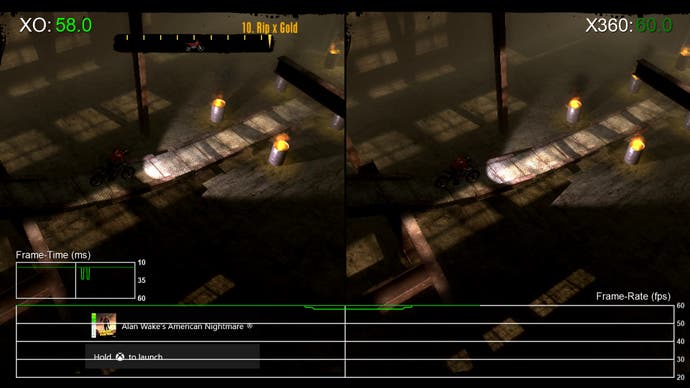
Alan Wake's American Nightmare
Status: Very playable, but presentation marred by awful black crush issues
Remedy's Xbox Live Arcade pseudo-sequel to the original Alan Wake has some issues but performance seemingly isn't one of them. Based on our tests, the title manages to match the performance profile of the game running on original hardware, and it does so without any of the screen-tear found in the original game. However, dropping adaptive v-sync does introduce more stutter as a consequence and the game doesn't feel quite as smooth as it does on Xbox 360, where the tearing wasn't quite so visible owing to the very dark palette.
What's curious about this title is that the original Xbox 360 release features support for both adaptive v-sync (smoother, with tearing) and a hard double-buffer v-sync, which sees the tearing replaced by sudden, sustained drops down to 20fps when the engine dips beneath the target frame-rate. In this sense, playing on Xbox One is obviously better - those intrusive lurches are gone.
However, the experience is compromised badly by a truly horrible black crush that robs the game of much of its detail, to the point where it's very, very difficult to actually see what you're doing in the initial part of the title. It may well be a case of rec.709 gamma not playing nicely with our capture kit here - but as you can see in the shot below, the Xbox 360 version looks fine. [UPDATE 29/3/16 10:14am: We're happy to say that the black crush issue on the Alan Wake titles has been fixed in a new update.]
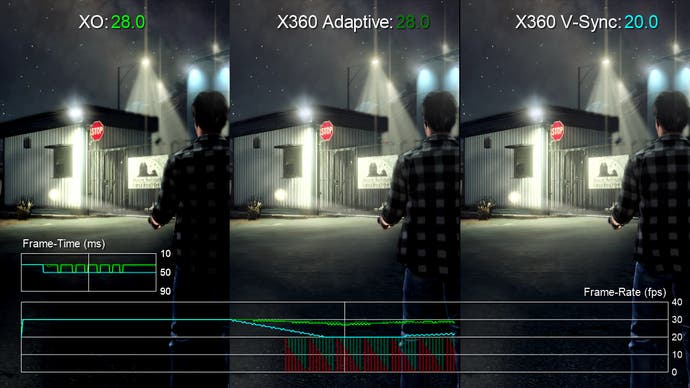
The Witcher 2: Assassin of Kings
Status: Very playable with moments of slowdown in combat
For its time, CD Projeck RED's The Witcher 2: Assassin of Kings was one of the most technologically advanced PC games money could buy - so the notion that the game could be down-ported to Xbox 360 felt far-fetched, to say the least. But in April 2012, that's exactly what happened, and through a combination of well-judged cutbacks and entire revisions of key systems, CDPR handed in a highly creditable experience.
Now it's available for Xbox One via backward compatibility, and it's well worth checking out - especially as for the time being, it's free to download for most users. The end result is intriguing: in common with many of the more demanding Xbox 360 games, there are areas where Xbox One provides enhanced performance, v-sync is fully enforced across the entire experience, while elsewhere, frame-rates lag behind the same code running on original hardware - a phenomenon that is mostly limited to combat encounters.
Microsoft chose this title to showcase the backward compatibility feature to Xbox One owners old and new, and we highly recommend that you check it out.
Gears of War 3
Status: Playable with some performance issues
As one of the most impressive titles on Xbox 360, Gears of War 3 is a great test for the backward compatibility feature and our first impressions were very positive indeed. Upon starting the game on both platforms we immediately noticed a boost in performance during real-time cut-scenes on Xbox One. When played on original hardware many of the game's cinematic sequences exhibit minor performance dips and screen-tearing that can detract from the presentation. On Xbox One, these issues are almost completely eliminated resulting in smoother overall playback across the game.
However, once the game begins proper, the narrative changes as we see the Xbox 360 pull ahead in terms of performance. Extended combat sequences tend to operate up to 10fps slower on Xbox One resulting in a less playable experience. It's fair to say that cut-scene demands differ significantly from battles against hordes of locust enemies supporting our theory that CPU heavy situations suffer the most from performance loss.
Similar to cut-scenes, we uncovered a number of other situations in which the Xbox One version outperforms the original hardware. Scenes in which alpha effects, such as smoke clouds, fill the screen operate at a higher frame-rate on Xbox One in many cases. We also noticed fewer hitches when transitioning between loading points, again suggesting faster IO operations on Xbox One.
We did spend some time playing Horde Mode and Team Deathmatch on Xbox One as well. Horde Mode suffers more than the single player campaign even with higher level matches spending a greater deal of time around 20fps. Team deathmatch, was much more positive with a mostly steady level of performance throughout. It's possible to hit occasional bouts of slowdown but the overall experience is very smooth indeed. We've also heard rumblings of increased input latency but, in our experience, the difference was negligible.
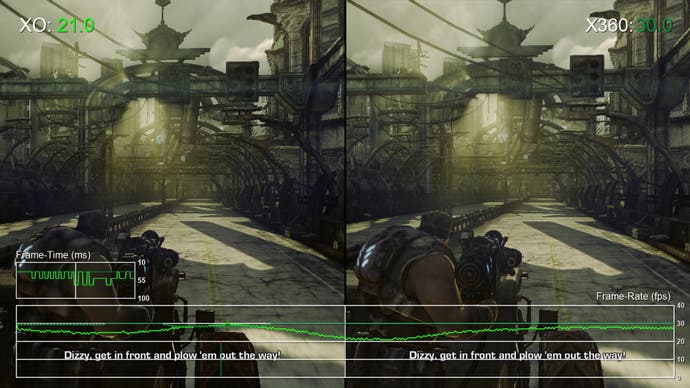
Gears of War
Status: Playable, often with improved performance
The original Gears of War stands as one of the first showcases for Microsoft's last generation platform. Released in 2006, it was Epic's first Unreal Engine 3 powered title - an experience which reached new heights in real-time rendering. Having been re-released as Gears of War Ultimate Edition for Xbox One recently, it's fascinating to return to the original release and get a feel for what has changed.
In this case, Gears manages to turn in decent performance on Xbox One, comparable to the original release running on native Xbox 360 hardware. In fact, many sections manage to run smoother on Xbox One in comparison while textures load much faster. Similar to other titles we've tested here, it's a great example of how the extra GPU power and smoother IO translates into tangible advantages for Xbox One.
As you'd expect though, performance issues only tend to crop up in combat sequences and the performance hit is less severe than what we encountered in Gears of War 3. Yet, on Xbox 360, many of these same sequences suffer from noticeable screen tearing and slowdown. In that sense, Gears of War actually feels better overall on Xbox One.
Gears of War 2
Status: Playable with minor slowdown
Gears of War 2 made its debut just two years after the original and introduced a host of improvements to the Unreal Engine, including enhanced fluid simulation, ambient occlusion, and improved lighting.
On Xbox 360, Gears 2 turns in relatively steady performance with an adaptive vertical sync solution handling moments of slowdown. On Xbox One, v-sync is maintained throughout, but performance is also generally very stable and much of that comes down to the fact that Gears 2 focuses on smaller skirmishes or set-piece moments avoiding the more strenuous situations that cause issues in many UE3 titles.
That said, there are still situations in which performance falls below what is possible on Xbox 360 hardware leading to reduced frame-rates and slower input response. Of the four Gears titles, however, Gears of War 2 is clearly one of the best in terms of overall performance.
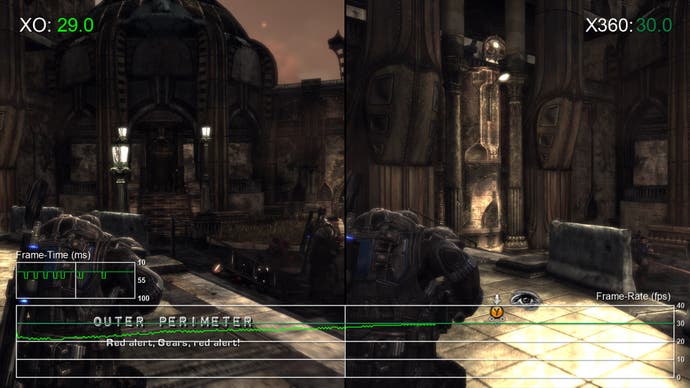
Gears of War Judgement
Status: Nearly unplayable due to severe performance drops
Released in 2013, Gears Judgement is the final installment in the franchise released on Xbox 360 and also the first Gears title developed by a studio other than Epic Games - in this case, People Can Fly (Bulletstorm/Painkiller) picked up the mantle. It's a game that has proven divisive amongst fans due to a very different type of single-player progression but it manages to play better than any other title in the series in many ways. It also happens to be one of the finest looking games on Xbox 360. The developer pushes the console to the absolute limit while taking advantage of every visual feature available in Unreal Engine 3 at the time.
Gears Judgement focuses more heavily on combat situations than previous games, with many areas more closely resembling horde mode than the more traditional single-player experience. With more enemies on screen than any other Gears title, it should be no surprise that Gears Judgement struggles on Xbox One. Nearly every major battle in the game is fraught with performance issues that send the frame-rate tumbling down to 20fps or below. Some of the larger areas are demanding to the point that frame-rate dips are observed even when enemies are eliminated.
Of all the Gears titles currently available, this is the only one that we might label unplayable on Xbox One. The experience is simply too compromised when compared against the game on original hardware. It's a shame too as this is likely one game that many Gears fans may have missed out on.
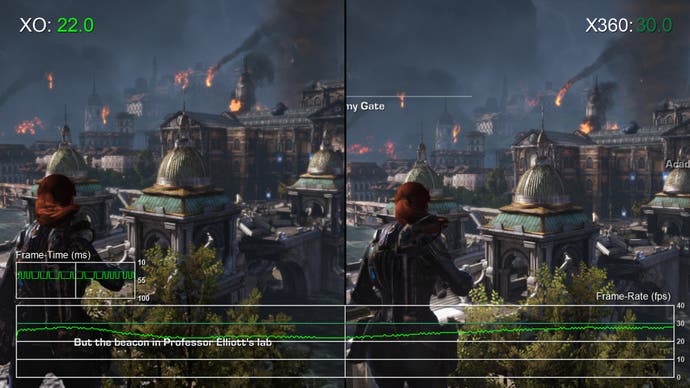
Halo Reach
Status: Nearly unplayable
Halo Reach is one of the most important titles in the backward compatibility line-up. It's the one Halo game that still isn't natively available on Xbox One and it's a game we've been eager to replay. It's one of the best Halo games ever made and it still holds up. Unfortunately, our hopes for Halo Reach on Xbox One were dashed almost immediately with highly unstable performance across the board. In many situations, the frame-rate drops well under 30fps even going below 15fps in some situations rendering the game almost unplayable.
Once it picks back up, however, things still fail to play out smoothly. Even when averaging 30fps, the game suffers from a near constant barrage of inconsistent frame persistence. Basically, frames are not being paced properly at all on Xbox One giving the impression of a frame-rate lower than the recorded 30fps. The experience is almost never consistent and it never really manages to feel smooth as a result - even in the very best of times. During gameplay you're either dealing with severe frame-pacing issues or severe frame-rate drops. Neither is pleasant and the game never feels right.
What's fascinating about these results is the fact that many of the more significant drops occur while moving between areas - a problem we noticed in the Master Chief Collection version of Halo 4. Perhaps CPU emulation is the bottleneck here then? Another common problem is sluggish texture loading which can leave objects without higher resolution assets for much longer than expected.
Ultimately, Halo Reach is the one true disappointment that we've tested thus far. The wildly inconsistent performance combined with texture draw-in problems result in something that just doesn't feel great to play. Dare we say it, but we have to wonder how Microsoft could approve this title for release when it is compromised so much.
Shadow Complex
Status: Almost perfect
As another Unreal Engine 3 title Shadow Complex offers something rather different from other games on this list. It's a side scrolling action adventure with a fixed camera perspective and room based progression. Making use of the engine's level streaming capabilities, Shadow Complex is a mostly seamless experience and turns in solid performance on Xbox One. The game targets 30fps and both Xbox One and Xbox 360 manage to hit this target the vast majority of the time.
As with other titles powered by Unreal Engine 3, the real-time cut-scenes in Shadow Complex actually manage to run much smoother on Xbox One. Scenes which operate as low as 20fps on Xbox 360 are bumped up to a full 30fps when using the backward compatibility feature.
This particular title was first introduced last year prior to the official rollout of the current dashboard and, based on our experiences at that time, the game has enjoyed significant performance improvements. Our initial playtest on Xbox One was fraught with significant slowdown during gameplay. Yet, in its current form, most of these issues have been cleared up resulting in a very stable game.

Mass Effect
Status: Exploration and cut-scenes are improved while combat is a mess
We examined this last summer during the initial rollout and we were curious to see how it holds up today. Unfortunately, the most significant issues remain unresolved, with Xbox One trailing behind Xbox 360 in most combat scenarios. The elimination of tearing is nice and, of course, textures manage to load faster but the controller response can become rather poor in these situations. As a game that already struggles on Xbox 360, the more significant dips on Xbox One can send performance numbers down into the low teens at points.
Yet, there are still points where the experience has improved. As with other Unreal Engine titles, cut-scenes see a noticeable boost in performance on Xbox One while non-combat gameplay tends to run smoother as well. This is particularly noticeable when driving the Mako. On Xbox 360, nearly every major Mako section struggles to hit the target frame-rate resulting in significant performance dips and tearing. In comparison, Xbox One manages to turn in a near perfect 30fps in many of these same sections eliminating much of the frustration.
The infamous elevator sequences also demonstrate an advantage in IO performance - elevators actually complete the loading cycle faster on Xbox One without disturbing performance. In fact, general exploration just feels smoother overall with more consistent frame-rates and faster texture loading. It really is only the combat situations that drag this one down. Ultimately, the 360 version of Mass Effect just doesn't run particularly well on either platform.
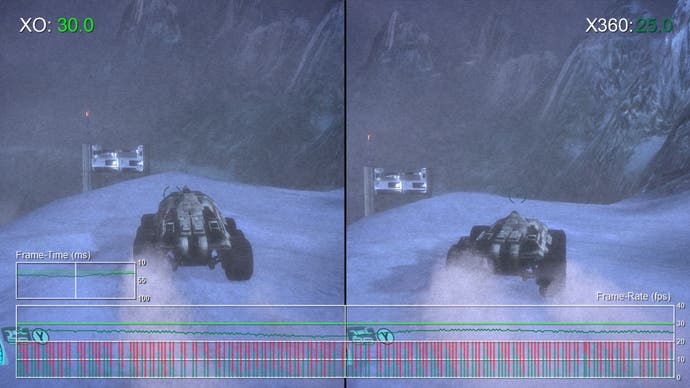
Hydro Thunder
Status: Better on Xbox One
Hydro Thunder Hurricane is one game that benefits greatly from running on Xbox One. The 360 version operates with an unlocked frame-rate with vertical sync disabled and as a result, screen-tear is present across the duration of gameplay. On Xbox One, vertical sync is enabled, completely removing this unwanted artefact. More importantly, this has almost no impact on general performance - both versions average around 45fps.
This, of course, leads to visible image judder as the frame-rate does not divide evenly into the refresh rate, but it's still preferable to ever-present tearing. Due to the unlocked nature of the frame-rate, it would certainly be interesting if performance were pushed further enabling frame-rates beyond the original. That's a tall order, of course, and rather unlikely but this is a perfect candidate for such a boost.
Either way, if you want to play this version of Hydro Thunder, it's definitely best on Xbox One.

Assassin's Creed 2
Status: Playable
There are many Assassin's Creed games available on Xbox 360 but thus far, only one of these is supported by Xbox One - Assassin's Creed 2. The series has never run at a particularly stable frame-rate on console, so we were interested to see how it would hold up on Xbox One. Not unlike the Unreal Engine 3 games discussed above, AC2 operates with a variable level of performance that sometimes places it ahead of Xbox 360 in select circumstances, while lagging behind in others.
It basically comes down to city performance versus the surrounding areas. The grassy plains around each of the large cities drop v-sync on Xbox 360 with obvious torn frames cutting into the fluidity. On Xbox One, these dips are completely cleared up and we're left with a very steady 30fps while exploring these areas.
Assassin's Creed II includes a number of different cities to explore and each city operates with a variable level of performance. In the worst case scenario, we see Xbox One trailing the 360 by a good 5fps or so while other cities come much closer to holding 30fps on both consoles. Regardless of the platform, Assassin's Creed 2 is still one of the best performing games in the series on consoles. If you're looking to revisit the game, rest assured that it works well on Xbox One.

N+
Status: Perfect
N+ is actually the reason we decided to test some of the more simplistic titles in the first place. When we first looked at the backward compatibility feature last year N+ did not run well on Xbox One. Performance was inconsistent with wild variations in frame-rate leading to an almost constant stutter. It just didn't play properly at all. After revisiting the title this year, however, we're happy to report that full performance is restored and N+ functions just as it did on Xbox 360.
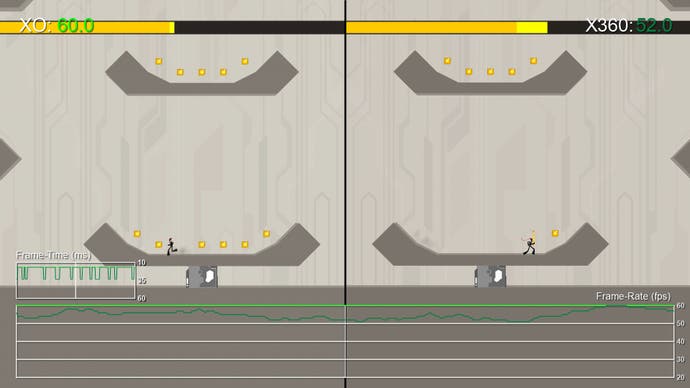
Braid
Status: Perfect
Braid helped usher in the indie revolution back in 2008 and it's nice seeing this title playable on Xbox One. While the visuals are fairly simple in design, we have run into instances with other similarly basic games failing to run well on Xbox One. Thankfully, that's not the case with Braid and we're left with a perfect 60fps experience, just as on Xbox 360. The hand-drawn art still looks good today and doesn't suffer from operating at a lower resolution.

Condemned
Status: Improved on Xbox One
Condemned was a memorable launch title for Xbox 360 so we were intrigued to see how it would hold up on Xbox One. The results are certainly rather interesting here and not at all what we expected. Basically, on Xbox One, we see an average frame-rate of around 45fps, which means plenty of image judder. During cut-scenes the 360 turns in a reasonably stable 30fps instead which actually looks much better in motion due to even frame distribution. However, during gameplay, we see something rather curious.
On Xbox 360, we actually see 30fps much of the time along with strange, momentary spikes to roughly 45fps. So, while playing, the game feels as if it is jumping back and forth between 30fps and the mid 40s leading to an inconsistent experience. On Xbox One, while judder is a real problem, the game at least manages to maintain a mostly consistent level of performance. It's certainly a strange game in this regard but due to consistency, we have to give the nod to Xbox One here.

Rainbow Six Vegas
Status: Sub-optimal performance but still playable
We spent some time sampling Vegas on Xbox One and Xbox 360 only to discover that this title suffers from pretty noticeable drops on Xbox One. While Vegas is indeed an Unreal Engine-powered game, it does not actually use UE3 - it's based on the older Warfare variation, much like the original Bioshock titles.
Even the smallest of fire fights struggled to hold 30fps in our tests leading to a sub-optimal experience. The performance never drops anywhere near as low as Halo Reach, so it does remain somewhat playable, but it definitely doesn't feel as responsive as it should. That's not to say it runs perfectly on Xbox 360, of course - on the original hardware vertical sync is often dropped in strenuous situations but the performance never dips quite as low as on Xbox One.

Xbox One backward compatibility: the Digital Foundry verdict
Since our first tests in July, it's clear that Xbox One backward compatibility has come a long way. Many of the issues we noted in our original tests have been cleared up - with improved performance to several titles a welcome result of the feature's extended beta period. It's nice to see the list of games growing and we can only hope that the few titles which do exhibit issues can be cleaned up further.
At this point it's safe to say that less demanding titles, such as Braid and N+, perfectly match the original experience on Xbox 360 making it a great time to jump back in. More demanding titles can prove hit or miss with certain games offering an experience better than the original while others fall behind. Games placing a greater demand on CPU tasks tend to suffer the most with strenuous situations often falling well behind an actual Xbox 360. We really need to see some work carried out here to improve the feature still further. On top of that, based on the experiences with key titles like Halo Reach and Gears of War: Judgement, we feel that stronger quality control is required before Microsoft releases a game. Reach in particular is one of the most important games in the line-up and in its current form, it's basically unplayable for much of the duration.
But the bottom line is that for the most part, Microsoft has got it right here, and being able to centralise two generations of Xbox titles into one box is a highly compelling proposition. If some of the remaining performance issues can be eliminated or reduced this could become the best way to experience classic Xbox 360 titles. The removal of screen-tear, faster loading, and almost flawless integration with a modern console all makes for a great experience. As backward compatibility continues to evolve in 2016 and beyond we'll continue to keep a close eye on it and report back with our findings.
